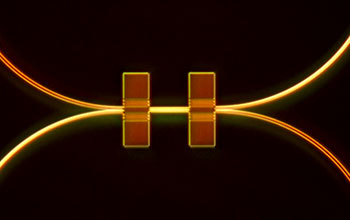Multimedia Gallery
Interacting Lightwaves Control Devices on Silicon Chip
A team of researchers at Yale University, led by professor Hong Tang, discovered a "repulsive" light force that can be used to control components on silicon microchips, meaning future nanodevices could be controlled by light rather than electricity. Funding for the project included a seed grant from the U.S. Defense Advanced Research Projects Agency and a Faculty Early Career Development (CAREER) Award from the National Science Foundation (ECCS 08-46919).
To learn more, see the Yale University news story Scientists Discover Light Force With "Push" Power. (Date of Image: 2009)
Credit: Hong Tang, Yale University
See other images like this on your iPhone or iPad download NSF Science Zone on the Apple App Store.
Images and other media in the National Science Foundation Multimedia Gallery are available for use in print and electronic material by NSF employees, members of the media, university staff, teachers and the general public. All media in the gallery are intended for personal, educational and nonprofit/non-commercial use only.
Images credited to the National Science Foundation, a federal agency, are in the public domain. The images were created by employees of the United States Government as part of their official duties or prepared by contractors as "works for hire" for NSF. You may freely use NSF-credited images and, at your discretion, credit NSF with a "Courtesy: National Science Foundation" notation.
Additional information about general usage can be found in Conditions.
Also Available:
Download the high-resolution JPG version of the image. (176 KB)
Use your mouse to right-click (Mac users may need to Ctrl-click) the link above and choose the option that will save the file or target to your computer.



